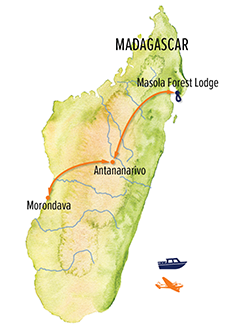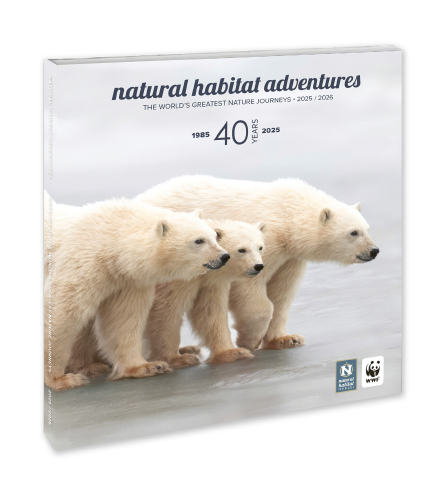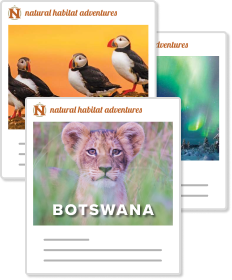Itinerary
Our adventure begins in Antananarivo, the capital of Madagascar. Known locally as "Tana," Madagascar's largest city is home to roughly 3 million people, while the balance of the island nation’s population lives mostly in rural areas. A transfer is included from the airport to our hotel on the outskirts of the city. An optional day tour of the capital is available for those who arrive early. This evening, meet your Expedition Leader and traveling companions at a welcome dinner.
Day 2: Private Flight to Maroantsetra / Masoala National Park
From Antananarivo, we fly by chartered plane to the small coastal trading town of Maroantsetra in the far northeast corner of the country. Here, we board a private boat across Antongil Bay to the Masoala Peninsula, covered in primary rainforest and protected within Masoala National Park, the largest of Madagascar’s conservation reserves. Containing extraordinary biodiversity, the park is part of the Rainforests of the Atsinanana World Heritage Site, which holds 50% of Madagascar’s species and 1% of the entire planet’s life forms. It contains the last remaining extensive coastal lowland rainforest in Madagascar, as well as interior mountain rainforest, flooded forest, marsh, mangroves and coral reefs.
Our base for four nights is Masoala Forest Lodge, a blissfully secluded eco-retreat accessible only by sea or on foot. On the edge of a sheltered cove surrounding by Masoala National Park and fronting a pristine beach that stretches for miles, the lodge is one with its environs. it faces the warm, coral-rich waters of the Tampolo Marine Reserve, home to colorful reef fish, endangered green, hawksbill and loggerhead sea turtles, bottlenose dolphins, and from July through September, hundreds of humpback whales that visit Antongil Bay during their long migration. Behind the lodge, a dense, untouched rainforest teems with life. This afternoon, we make our first foray along the beach and into the forest, commencing our quest to spot a wide variety of Madagascar’s intriguing wildlife. Eventually it’s time for cocktails around the bonfire, as the sky is transformed into shades of orange and rose by one of Madagascar’s famous sunsets.
Days 3 — 5: Exploring Masoala National Park & Tampolo Marine Reserve

The next three days offer an immersion in the magic of coastal Madagascar. With our Expedition Leader and local Malagasy guides, head into this richly layered ecosystem in search of wondrous wildlife. Coveted bird sightings include helmet vanga, blue coua, nelicourvi weaver and various kingfishers. Lemurs are a highlight and our odds are good to spy red-ruffed lemurs, endemic to the Masoala Peninsula. We are also likely to spot northern bamboo lemurs and white-fronted brown lemurs—some of the nearly 100 lemur species found in Madagascar and nowhere else, as these primitive primates evolved in isolation on the island over the last 50 million years. Our guides also help us look for the greater hedgehog tenrec, brown-tailed mongoose, leaf-tailed geckos, Madagascar serpent eagle and dozens of butterfly species. After dark, forest walks reveal animals that become active at night, including sportive, woolly and mouse lemurs. With exceptional luck, we might glimpse a highly elusive aye-aye, surrounded by a chorus of night sounds created by frogs, insects and nocturnal birds.
In the forest, waterfalls pour off verdant cliffs into crystalline streams. The sea beckons, too, inviting us to snorkel in the clear aquamarine waters of the Tampolo Marine Reserve. Or kayak among the islands, basalt formations, reefs and rocky coves fringed with palms as we watch community fishing boats pursue their sustainable daily catch. During our stay, we’ll walk along the coast to the mouth of the Tampolo River where we board a pirogue—a traditional dugout canoe—to glide up the glassy waterway in search of more intriguing wildlife.
On a visit to the village of Ambodiforaha, meet the people, learn about their culture, and enjoy a song and dance performance. Crafts created by local artisans are available for sale at a small market at our lodge, along with vanilla, cloves and other spices that are hallmarks of Madagascar. We may also visit a reforestation project for a close-up look at how native habitat is being successfully restored to provide a home for returning wildlife. A highlight of our stay is a traditional Malagasy dinner, plus tastings of local rums infused with native fruits and spices.
Day 6: Private Chartered Flights to Antananarivo & Morondava / Avenue of the Baobabs
Today we retrace our flight route to Antananarivo, then transfer to another chartered flight to Morondava on the west coast of Madagascar. On landing, we drive to our hotel, a collection of thatched bungalows overlooking the powdery white sand of Nosy Kely Beach on the Mozambique Channel. The bungalows are set among gardens scattered with coconut palms, perfectly situated to take in the stunning sunsets over the Indian Ocean. On our first evening, however, we enjoy the sunset from a different location: the famous Avenue of the Baobabs, about 40 minutes away by road. These massive trees, which line a dirt path leading to the Tsiribihina River, are a nearly thousand-year-old legacy of the dense tropical forests that once covered this landscape. Over the centuries, as Madagascar’s population grew, the forests were steadily cut down, yet these dramatic specimens remain, icons of the country’s native ecosystems and cultural heritage. Rising almost 100 feet tall, baobabs ave straight, cylindrical trunks that grow up to 10 feet in diameter. Their flat-topped crowns create an evocative silhouette at sunset. With rains, baobabs put out a profusion of flowers, drawing bats, beetles, moths and other insects to feed on their sweet nectar. The baobab’s fruit is about the size of a large coconut and is eaten by lemurs as well as humans. The bark of the baobab is used as a fiber for rope, cloth, nets, baskets and paper. The baobab’s status as a keystone species holds special importance in its ecosystem, yet in addition to deforestation, climate change also threatens their survival, and we learn about conservation efforts to protect the remaining trees. Of the seven baobab species that grow in Madagascar, six are endemic to the island.
Day 7: Sunrise at the Baobabs / Fishing Village / Mangrove Exploration
Those who wish to rise early may return to the Avenue of the Baobabs at dawn for sunrise photographs. Later today, we visit a local fishing village to meet some of the fishers and learn about this traditional sustainable lifestyle. We also explore a mangrove ecosystem to discover why this threatened habitat holds such importance for Madagascar, which has the second-largest expanse of mangroves in the western Indian Ocean. In addition to providing nesting sites for birds and sea turtles and sheltering commercially valuable crab and shrimp, mangrove forests support connections between ecosystems such as coral reefs and seagrass beds. With stilt-like root systems, mangroves trap mud, filter water and safeguard coastlines against tidal surges. They are also amazing carbon sinks, storing up to four times more carbon than tropical rainforests. However, mangroves are rapidly disappearing, threatened by sea level rise, upstream erosion and deforestation. Since 2007, WWF has partnered with local communities to protect and regenerate these incredibly biodiverse coastal forests, and we learn about their achievements during our visit. Tonight, we conclude our Madagascar discovery with a festive farewell dinner.
Day 8: Private Chartered Flight to Antananarivo / Depart
After breakfast this morning, fly back to the capital city of Tana by private chartered aircraft, then transfer to the international airport to departing flights.

























